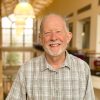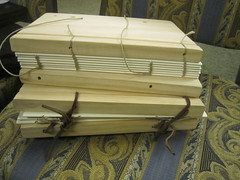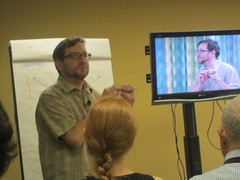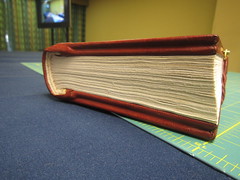This article is more than 5 years old.
I attended three sessions this year and was delighted that these focused on binding and books.
Martha Little spoke on “Evidence of Structure and Procedure in Books.” Martha has been the Head Conservator at the University of Michigan Libraries and Book Conservator at Yale. Her presentation was a kind of deconstruction of the historical book. It was partly taking books apart to understand them and partly examining stains, sewing and even pest damage. She literally took historic structures apart to understand them. This included a two-volume set of Homer which had been sewn together and a new leather cover applied to hide the fact. She told how two book scholars (Roger Powell and Berthe van Regemorter) examined an identical Ethiopian binding and came to very different conclusions about how it was made. Little made models of both these books to show us who was likely more correct in their theory (Powell). Martha tested adhesives using the reagent potassium iodide to show the presence of starch adhesives. She also made cord using linen thread which she plied together using a hand drill to make a heavy cord that could be used to sew signatures onto. Martha also examined how books were put together and successively re-sewn over time. She did this using a guide developed in England at Trinity College, by mapping sewing holes, saw kerfs, and tackets on the text block and book boards. Martha made a diagram from the sewing holes which showed the binding and re-sewing over time. A real lesson in book construction history!
Martha Little’s models of Ethiopian binding
Jeff Peachey gave a great presentation on Late 18th century French binding structures. Peachey is a book conservator in NYC and the inventor of several machines for binding and also makes a variety of well-respected leather paring knives. Jeff is also a book conservator of the first order-hence, his project was bolstered by historical research and hands-on knowledge of binding. Peachey conducted research of the Diderot Encyclopedie (we have a complete set in our collection) to determine how bindings were constructed in 18th century France. The Diderot is not a traditional encyclopedia, but a how-to manual complete with diagrams and illustrations of various processes. During his session, Jeff demonstrated how to construct one of these bindings taken from the pages of Diderot. He used demonstrations and pre-made models to do this, along with illutrations from the pages of Diderot. It was fascinating to see Jeff, demonstrate binding, tool sharpening, ploughing (plowing) and leather paring, as well as his model of 18th century binding.
Michael Burke presented the third session on Byzantine Binding. Michael currently teaches binding in England, but has also been involved in the San Francisco Center for the Book. His presentation used historic books from the Byzantine period (circa 300-1200 AD) to construct a model of this style of binding. The book has wooden boards, quarter-sawn and drilled. The text block is sewn up in halves and then joined together. This style of binding is beautiful, but and Michael was unsure why it was sewn in halves-no doubt a question lost to history.
I had several meals with Tony Gardner, President of the GBW California Chapter and former Head of Special Collections at Cal State, Northridge. Tony has experience working with his library development officer and shared how his institution conducted outreach using their collection.
I also had the opportunity to meet several suppliers:
Marge Salik and her daughter from Talas.
Nancy Morains from Colophon Book Arts Supply.
All in all, I attended a great series of sessions on book structure and history, made a number of good contacts and had some invaluable discussions with other professionals interested in binding.






3 Comments on ‘GBW Standards of Excellence- Presentations’
Wow, really interesting. I would have loved to see the Diderot demo!
Sounds like characters from “People of the Book!”
Right from the pages of People from the Book- we discussed the same idea as a team yesterday morning! Thanks for sending me!